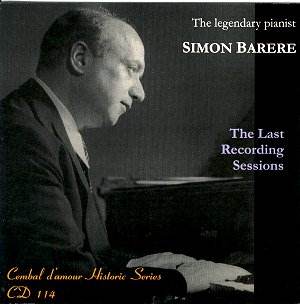These were Simon Barere’s last recordings and ones he was
destined never even to hear. A week or so later, on 2 April 1951, he suffered a massive haemorrhage on stage performing the Grieg Concerto,
a piece he’d never before played. He was accompanied by Eugene Ormandy
and the Philadelphia Orchestra. There were no edits in these solo discs
– Barere disliked the process. What one hears is essentially a single
take. For all his colossal reputation as a master technician, as one
of the most dazzling virtuosi in a century
not illiberally sprinkled with phenomenal talents, what this Final Testament
shows is that Barere’s prodigious feats of dexterity were not disassociated
from equally memorable shafts of poetic insight. He could dazzle but
he could charm as well. One is almost invariably aware throughout this
disc of the sense of control Barere possessed. That control both animated
and gave proper structural weight to his performances. There are very
few instances, if any, where beauty of tone or colouristic potential
is sacrificed to the dictates of mere velocity or mindless bravura.
In fact the only performance with which I could take real exception
is La Campanella where for all his stunning playing the results
sound over-heated.
In the Faust Waltz the bravura, in a work susceptible to
lopsided interpretation, is accompanied by rigorous clarity, by a defining
control, by a tempo that is never unreasonably fast and by a range of
colouristic devices that give enormous life to the music. So too Gnomenreigen, where contra any preconceptions, Barere
is fluent but once more capable of rigorous constraint, though maybe
fractionally inferior to his 1934 London recording.
He is obviously much faster than an older Lisztian such as Frederic
Lamond whose aesthetic impulses – and inferior technique - were distinct
from Barere’s. His Petrarch Sonnet possesses a marvellous texture and
is expressive into the bargain. La Leggierezza brings out his
vast reserves of colour and poetry. Maybe the Don Juan Reminiscences
fall very occasionally short of Barere’s exalted standard. His 1934/36
HMV set made in London is unmatched. However these are still mightily
impressive. As I suggested above it’s only La Campanella that
disturbed me. In fact he hadn’t – apparently - played it for ten years
before these sessions and didn’t realize it was being recorded which
might explain that whilst it starts superbly it ends in a supercharged
attack that tips it over the edge. But the two Chopin pieces – the Scherzo
and Ballade – are beautifully done and more than make amends, should
any have been necessary. Even at the very end of his sadly curtailed
life Barere’s admixture of virtuosity and poetry remained intact.
Jonathan Woolf
